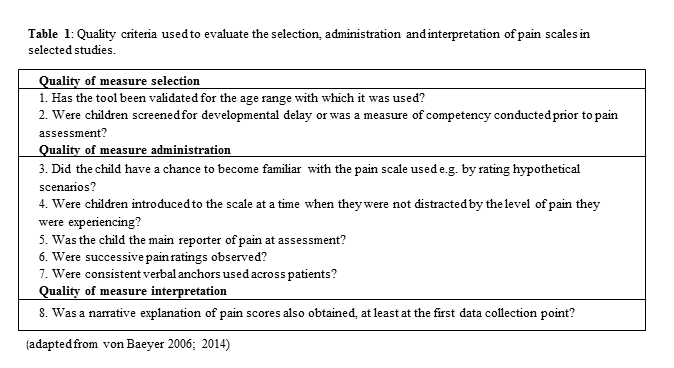Session Information
Session Type: ACR Poster Session A
Session Time: 9:00AM-11:00AM
Background/Purpose: Pain is often the most troubling feature of musculoskeletal disease in children and young people (CYP). In paediatric pain research, recent attempts to standardise the assessment of chronic pain for CYP have been pivotal in establishing which measures should be used. However, guidance about how pain assessments should be administered is extremely limited. Furthermore, inconsistencies exist in pain scoring systems used to classify chronic pain as mild, moderate or severe in CYP. The aim of this review was to evaluate current evidence on pain assessment administration, scoring and pain classification in CYP with chronic pain.
Methods: Medline, EMBASE, CINAHL and PsycInfo were searched (inception to 18th January 2016) for studies in which uni-dimensional, self-report, pain assessments were used with CYP (aged 5-18 years) who suffered from a chronic pain condition (or illness conditions in which chronic pain was a feature). Two researchers reviewed full-text articles independently of each other for inclusion. Disagreements were identified and reviewed for inclusion by a third reviewer. Selected studies were critically appraised by the two independent reviewers. Quality criteria were adapted from existing recommendations for the selection, administration and interpretation of self-report scales with children. The maximum possible score was 8.
Results: Thirty-five studies were included from a sample of 628. Five papers reported the use of several scales. A total of 40 reports met the inclusion criteria for full review and used one or more of the following assessment types; Visual Analogue Scales, Numerical Rating Scales, Faces Pain Scales, Body Maps. None of the pain assessments undertaken met all quality criteria. The highest score achieved was 5 out of a maximum of 8, the lowest was 0 (median=3, IQR=3-4). Key administrative details were missing from the majority of reports with 22 failing to provide details of how the assessment was scored. Only two articles provided details of how pain scores were classified.
Conclusion: Pain assessments were rarely administered in accordance with existing administrative guidance. The rationale for how pain measures were utilised with CYP with chronic pain was seldom provided and the reporting of pain assessments was poor. Details on the systems used to score and classify pain were missing in most published papers. Lack of standardisation remains a problem in chronic pain research. The finding of this review suggest that implementation of guidance for how to use, score and report pain assessment tools with CYP in chronic pain is necessary for both clinical practice and research.
To cite this abstract in AMA style:
Lee R, Rashid A, Ghio D, Thomson W, Cordingley L. A Systematic Review of Chronic Pain Assessments with Children and Young People: Exploring Administrative, Scoring and Classification Issues [abstract]. Arthritis Rheumatol. 2016; 68 (suppl 10). https://acrabstracts.org/abstract/a-systematic-review-of-chronic-pain-assessments-with-children-and-young-people-exploring-administrative-scoring-and-classification-issues/. Accessed .« Back to 2016 ACR/ARHP Annual Meeting
ACR Meeting Abstracts - https://acrabstracts.org/abstract/a-systematic-review-of-chronic-pain-assessments-with-children-and-young-people-exploring-administrative-scoring-and-classification-issues/


